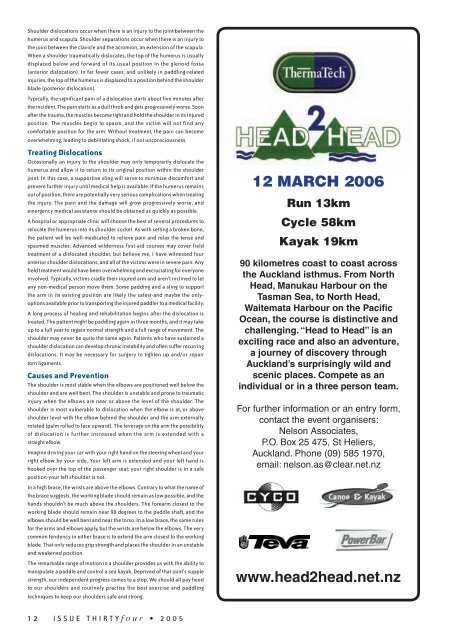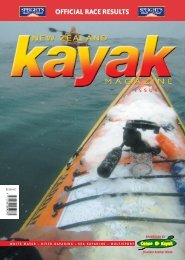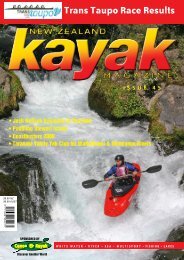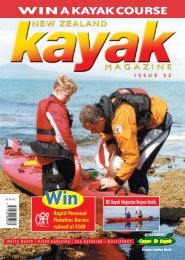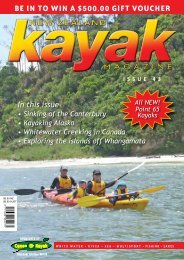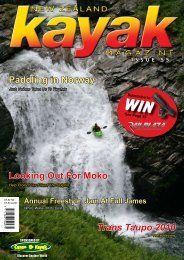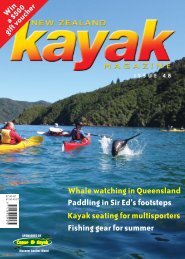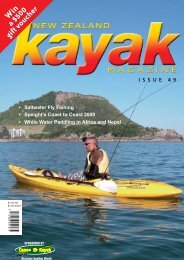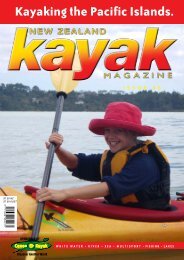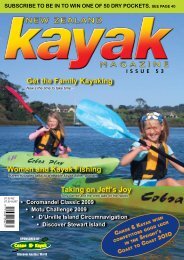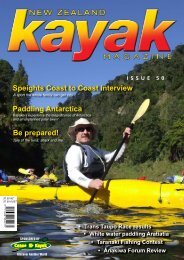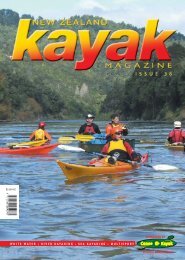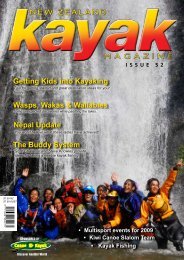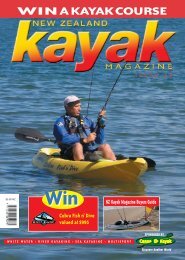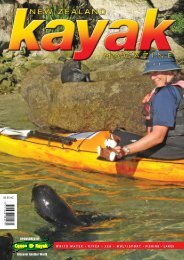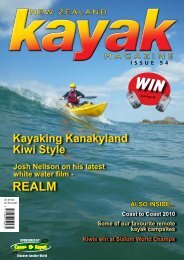C&K mag #34 dps-f spg - Canoe & Kayak
C&K mag #34 dps-f spg - Canoe & Kayak
C&K mag #34 dps-f spg - Canoe & Kayak
You also want an ePaper? Increase the reach of your titles
YUMPU automatically turns print PDFs into web optimized ePapers that Google loves.
Shoulder dislocations occur when there is an injury to the joint between the<br />
humerus and scapula. Shoulder separations occur when there is an injury to<br />
the joint between the clavicle and the acromion, an extension of the scapula.<br />
When a shoulder traumatically dislocates, the top of the humerus is usually<br />
displaced below and forward of its usual position in the glenoid fossa<br />
(anterior dislocation). In far fewer cases, and unlikely in paddling-related<br />
injuries, the top of the humerus is displaced to a position behind the shoulder<br />
blade (posterior dislocation).<br />
Typically, the significant pain of a dislocation starts about five minutes after<br />
the incident. The pain starts as a dull throb and gets progressively worse. Soon<br />
after the trauma, the muscles become tight and hold the shoulder in its injured<br />
position. The muscles begin to spasm, and the victim will not find any<br />
comfortable position for the arm. Without treatment, the pain can become<br />
overwhelming, leading to debilitating shock, if not unconsciousness.<br />
Treating Dislocations<br />
Occasionally an injury to the shoulder may only temporarily dislocate the<br />
humerus and allow it to return to its original position within the shoulder<br />
joint. In this case, a supportive sling will serve to minimize discomfort and<br />
prevent further injury until medical help is available. If the humerus remains<br />
out of position, there are potentially very serious complications when treating<br />
the injury. The pain and the da<strong>mag</strong>e will grow progressively worse, and<br />
emergency medical assistance should be obtained as quickly as possible.<br />
A hospital or appropriate clinic will choose the best of several procedures to<br />
relocate the humerus into its shoulder socket. As with setting a broken bone,<br />
the patient will be well-medicated to relieve pain and relax the tense and<br />
spasmed muscles. Advanced wilderness first-aid courses may cover field<br />
treatment of a dislocated shoulder, but believe me, I have witnessed four<br />
anterior shoulder dislocations, and all of the victims were in severe pain. Any<br />
field treatment would have been overwhelming and excruciating for everyone<br />
involved. Typically, victims cradle their injured arm and aren’t inclined to let<br />
any non-medical person move them. Some padding and a sling to support<br />
the arm in its existing position are likely the safest-and maybe the onlyoptions<br />
available prior to transporting the injured paddler to a medical facility.<br />
A long process of healing and rehabilitation begins after the dislocation is<br />
treated. The patient might be paddling again in three months, and it may take<br />
up to a full year to regain normal strength and a full range of movement. The<br />
shoulder may never be quite the same again. Patients who have sustained a<br />
shoulder dislocation can develop chronic instability and often suffer recurring<br />
dislocations. It may be necessary for surgery to tighten up and/or repair<br />
torn ligaments.<br />
Causes and Prevention<br />
The shoulder is most stable when the elbows are positioned well below the<br />
shoulder and are well bent. The shoulder is unstable and prone to traumatic<br />
injury when the elbows are near or above the level of the shoulder. The<br />
shoulder is most vulnerable to dislocation when the elbow is at, or above<br />
shoulder level with the elbow behind the shoulder and the arm externally<br />
rotated (palm rolled to face upward). The leverage on the arm the possibility<br />
of dislocation is further increased when the arm is extended with a<br />
straight elbow.<br />
I<strong>mag</strong>ine driving your car with your right hand on the steering wheel and your<br />
right elbow by your side. Your left arm is extended and your left hand is<br />
hooked over the top of the passenger seat; your right shoulder is in a safe<br />
position-your left shoulder is not.<br />
In a high brace, the wrists are above the elbows. Contrary to what the name of<br />
the brace suggests, the working blade should remain as low possible, and the<br />
hands shouldn’t be much above the shoulders. The forearm closest to the<br />
working blade should remain near 90 degrees to the paddle shaft, and the<br />
elbows should be well bent and near the torso. In a low brace, the same rules<br />
for the arms and elbows apply, but the wrists are below the elbows. The very<br />
common tendency in either brace is to extend the arm closest to the working<br />
blade. That only reduces grip strength and places the shoulder in an unstable<br />
and weakened position.<br />
The remarkable range of motion in a shoulder provides us with the ability to<br />
manipulate a paddle and control a sea kayak. Deprived of that joint’s supple<br />
strength, our independent progress comes to a stop. We should all pay heed<br />
to our shoulders and routinely practise the best exercise and paddling<br />
techniques to keep our shoulders safe and strong.<br />
12 ISSUE THIRTYfour • 2005<br />
12 MARCH 2006<br />
Run 13km<br />
Cycle 58km<br />
<strong>Kayak</strong> 19km<br />
90 kilometres coast to coast across<br />
the Auckland isthmus. From North<br />
Head, Manukau Harbour on the<br />
Tasman Sea, to North Head,<br />
Waitemata Harbour on the Pacifi c<br />
Ocean, the course is distinctive and<br />
challenging. “Head to Head” is an<br />
exciting race and also an adventure,<br />
a journey of discovery through<br />
Auckland’s surprisingly wild and<br />
scenic places. Compete as an<br />
individual or in a three person team.<br />
For further information or an entry form,<br />
contact the event organisers:<br />
Nelson Associates,<br />
P.O. Box 25 475, St Heliers,<br />
Auckland. Phone (09) 585 1970,<br />
email: nelson.as@clear.net.nz<br />
www.head2head.net.nz


